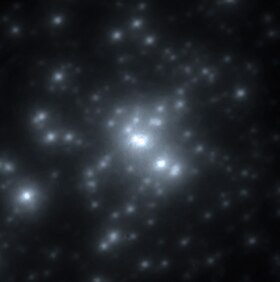R136a1
 A near infrared image of the R136 cluster, obtained at high resolution with the MAD adaptive optics instrument at ESO’s Very Large Telescope. R136a1 is resolved at the center with R136a2 close by, R136a3 below right, and R136b to the left. Credit: ESO/VLT |
|
| Observation data Epoch J2000.0 Equinox J2000.0 |
|
|---|---|
| Constellation | Dorado |
| Right ascension | 5h 38m 42.39s |
| Declination | −69° 06′ 02.91″ |
| Apparent magnitude (V) | 12.23 |
| Characteristics | |
| Evolutionary stage | Wolf–Rayet star |
| Spectral type | WN5h |
| B−V color index | 0.03 |
| Astrometry | |
| Distance | 163,000 ly (49,970pc) |
| Absolute magnitude (MV) | −8.09 |
| Details | |
| Mass |
315+60 −50 M☉ |
| Radius | 28.8-35.4 R☉ |
| Luminosity | 8,710,000 L☉ |
| Luminosity (visual, LV) | 150,000 L☉ |
| Surface gravity (log g) | 4.0 cgs |
| Temperature | 53,000 ± 3000 K |
| Age | 0 - 0.8 Myr |
| Other designations | |
| Database references | |
| SIMBAD | data |
RMC 136a1 (usually abbreviated to R136a1) is a Wolf–Rayet star located at the center of R136, the central condensation of stars of the large NGC 2070 open cluster in the Tarantula Nebula. It lies at a distance of about 50 kiloparsecs (163,000 light-years) in a neighbouring galaxy known as the Large Magellanic Cloud. It has the highest mass and luminosity of any known star, at 315 M☉ and 8.7 million L☉, and is also one of the hottest at around 53,000 K.
In 1960, a group of astronomers working at the Radcliffe Observatory in Pretoria made systematic measurements of the brightness and spectra of bright stars in the Large Magellanic Cloud. Among the objects cataloged was RMC 136, (Radcliffe observatory Magellanic Cloud catalog number 136) the central "star" of the Tarantula Nebula, which the observers concluded was probably a multiple star system. Subsequent observations showed that R136 was located in the middle of a giant region of ionized interstellar hydrogen known as an H II region that was a center of intense star formation in the immediate vicinity of the observed stars.
In 1979, ESO's 3.6 m telescope was used to resolve R136 into three components; R136a, R136b, and R136c. The exact nature of R136a was unclear and a subject of intense discussion. Estimates that the brightness of the central region would require as many as 100 hot O class stars within half a parsec at the centre of the cluster led to speculation that a star 3,000 times the mass of the Sun was the more likely explanation.
...
Wikipedia
